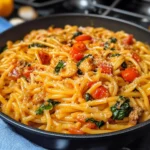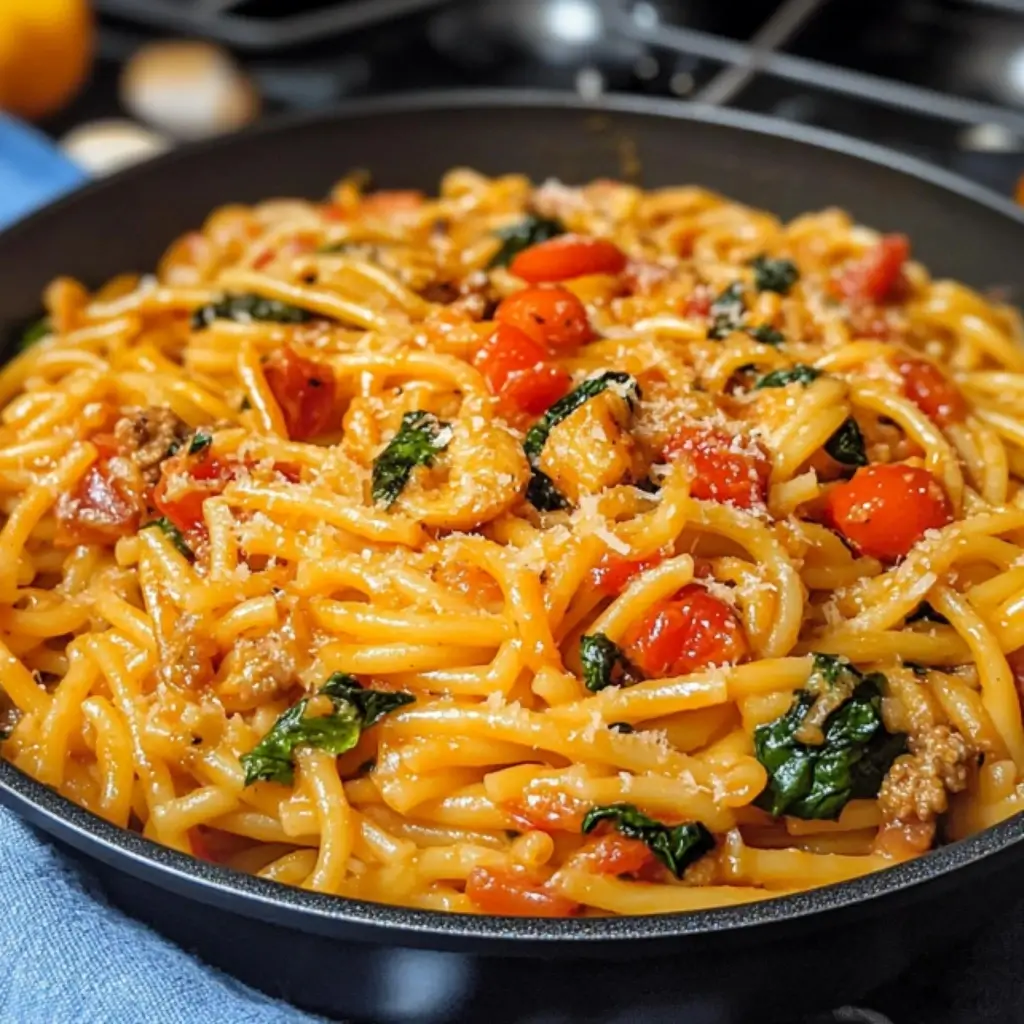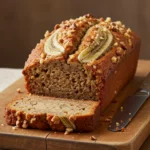Introduction
Honestly, weeknights can be chaotic, right? Between work, errands, and everything else life throws at you, the last thing you want is a complicated, multi-dish dinner. That’s why this One-Pot Veggie Pasta recipe has become a staple in our house. From the moment I stumbled upon it, it was a game-changer. My family, even the picky eaters, absolutely devoured it! The beauty of this recipe isn’t just in its simplicity; it’s the explosion of flavors you get from such minimal effort. The vibrant veggies meld together beautifully with the rich tomato sauce and perfectly cooked pasta, all in one single pot! Cleanup is a breeze, and the taste is anything but basic. If you’re looking for a healthy, delicious, and incredibly easy meal that will quickly become a family favorite, look no further. This One-Pot Veggie Pasta is about to become your new weeknight hero.
Why You’ll Love This One-Pot Veggie Pasta Recipe
In today’s fast-paced world, convenience is king, but we also crave meals that are both nourishing and delicious. This One-Pot Veggie Pasta recipe perfectly balances these needs, making it a winning choice for busy individuals and families alike. Here’s why you’ll be making this recipe again and again:
- Unbelievably Easy: Seriously, it’s almost too good to be true. Everything cooks in one pot, from start to finish. No pre-boiling pasta, no separate saucepans – just simple, streamlined cooking.
- Ready in Under 30 Minutes: From chopping veggies to plating up, this meal is on the table in about half an hour. Perfect for those nights when time is of the essence.
- Minimal Cleanup: The dream of every home cook! One pot means one pot to wash. Say goodbye to mountains of dishes and hello to more free time.
- Budget-Friendly: Packed with affordable vegetables and pantry staples, this recipe is kind to your wallet without compromising on flavor or nutrition.
- Customizable to Your Taste: Don’t have red bell peppers? Use yellow or orange! Love spinach? Throw it in! This recipe is incredibly versatile and adapts easily to whatever vegetables you have on hand or your family prefers.
- Healthy and Nutritious: Loaded with fresh vegetables, this pasta dish is a fantastic way to boost your veggie intake. It’s a wholesome and satisfying meal that you can feel good about serving.
- Family-Friendly: Even picky eaters are often won over by the familiar comfort of pasta combined with the subtle sweetness of cooked vegetables and a flavorful tomato sauce. It’s a meal that pleases all ages.
- Perfect for Meal Prep: One-Pot Veggie Pasta reheats beautifully, making it ideal for meal prepping lunches or dinners for the week ahead. Make a big batch and enjoy effortless meals throughout the week.
Gather Your Ingredients: The Star Players of This One-Pot Wonder
The beauty of this recipe lies in its simplicity, and the ingredients are readily available in most kitchens or local grocery stores. Each ingredient plays a crucial role in creating a harmonious and flavorful dish. Let’s break down the ingredients and why they are essential:
- 1 tablespoon olive oil: Olive oil is the foundation of many great dishes, and this pasta is no exception. It’s used to sauté the vegetables, adding a rich, fruity flavor and preventing them from sticking to the pan. Opt for extra virgin olive oil for the best taste and health benefits.
- 1 medium red onion, finely chopped: Red onion brings a slightly sweet and pungent flavor to the dish. When sautéed, it mellows out and adds depth and complexity to the overall taste. Finely chopping ensures it cooks evenly and blends seamlessly into the sauce.
- 2 large garlic cloves, chopped: Garlic is a flavor powerhouse! It provides a pungent, aromatic base that enhances all the other ingredients. Freshly chopped garlic is always recommended for the most intense flavor.
- 1 medium red bell pepper, diced: Red bell pepper adds a touch of sweetness and a vibrant color to the pasta. It’s also packed with Vitamin C and other nutrients. Dicing ensures it cooks quickly and evenly. Feel free to use other colors of bell peppers as well for variety and different flavor nuances.
- 1 medium zucchini, diced: Zucchini is a mild and versatile vegetable that adds a delicate texture and slight sweetness to the dish. It absorbs flavors beautifully and cooks quickly in the one-pot method. You can also use yellow squash or a mix of both.
- 250 g (½ lb) mushrooms, sliced: Mushrooms bring an earthy, umami flavor that deepens the overall taste profile of the pasta. Sliced mushrooms cook quickly and add a meaty texture that makes the dish more satisfying. Cremini, button, or even a mix of wild mushrooms would work wonderfully.
- 2 tablespoons tomato paste: Tomato paste is a concentrated form of tomatoes that adds a rich, intense tomato flavor and helps to thicken the sauce. It provides a depth of flavor that regular diced tomatoes alone cannot achieve.
- ½ tablespoon Italian seasoning mix: Italian seasoning is a blend of dried herbs like oregano, basil, rosemary, thyme, and marjoram. It provides that classic Italian flavor profile that perfectly complements the vegetables and tomato sauce. You can also adjust the herbs to your personal preference if you have individual dried herbs on hand.
- 500 ml (2 cups) vegetable stock (or water): Vegetable stock is the cooking liquid for the pasta. It adds flavor and helps to create a light and flavorful sauce as the pasta cooks and releases its starch. If you don’t have vegetable stock, water can be used as a substitute, but stock will enhance the overall taste.
- 250 g (½ lb) uncooked short pasta: Short pasta shapes like penne, fusilli, rotini, or rigatoni work best for this recipe. Their shape allows them to cook evenly in the one-pot method and hold onto the sauce beautifully. Choose your favorite short pasta shape!
- 500 ml (2 cups) pasta sauce: Pasta sauce forms the base of the flavor for this dish. Use your favorite store-bought pasta sauce, or even better, homemade if you have it on hand! Marinara, arrabbiata, or a simple tomato and basil sauce are all excellent choices.
- 125 g (1 ½ cups) light mozzarella, grated: Mozzarella cheese adds a creamy, melty finish to the pasta. Light mozzarella is used to keep the dish a bit lighter, but you can use full-fat mozzarella for a richer flavor. Other cheeses like provolone or a blend of Italian cheeses would also be delicious.
- Salt and freshly ground black pepper to taste: Salt and pepper are essential for seasoning and enhancing the flavors of all the ingredients. Season to taste throughout the cooking process, and especially at the end. Freshly ground black pepper provides a more aromatic and robust flavor than pre-ground pepper.
- Freshly grated Parmesan or vegetarian hard cheese, to serve, optional: Parmesan cheese adds a salty, umami, and slightly nutty flavor that complements the pasta perfectly. Vegetarian hard cheese is a great alternative for vegetarian diets. This is an optional topping, but it really elevates the dish.
Step-by-Step Guide: Mastering One-Pot Veggie Pasta
Making this One-Pot Veggie Pasta is incredibly straightforward. Follow these simple steps and you’ll have a delicious and satisfying meal ready in no time:
Step 1: Sauté the Aromatics and Hearty Vegetables
- Heat the olive oil: Place a large, deep pan or Dutch oven over medium heat. Add the olive oil and let it heat up for a few seconds until it shimmers. This ensures the vegetables won’t stick and will sauté properly.
- Sauté onion, garlic, and red pepper: Add the finely chopped red onion to the hot oil and sauté for 2-3 minutes, stirring occasionally, until it softens and becomes translucent. Then, add the chopped garlic and diced red bell pepper. Continue to sauté for another 1-2 minutes, until the garlic becomes fragrant and the bell pepper starts to soften slightly. Tip: Don’t let the garlic brown, as it can become bitter.
Step 2: Add the Remaining Vegetables and Flavor Enhancers
- Incorporate zucchini and mushrooms: Add the diced zucchini and sliced mushrooms to the pan. Stir them in with the other vegetables and cook for another 2-3 minutes, until they begin to soften and release some of their moisture. Tip: Avoid overcrowding the pan, as this can steam the vegetables instead of sautéing them. If your pan is too small, you may need to sauté the vegetables in batches.
- Stir in tomato paste and Italian seasoning: Add the tomato paste and Italian seasoning mix to the pan. Stir everything well to combine, coating the vegetables evenly with the tomato paste and spices. Cook for about 1 minute, stirring constantly, to toast the tomato paste slightly. This intensifies its flavor and adds depth to the sauce.
Step 3: The One-Pot Magic: Pasta and Sauce Come Together
- Pour in vegetable stock, pasta, and pasta sauce: Pour in the vegetable stock (or water) into the pan. Then, add the uncooked short pasta and the pasta sauce.
- Combine and bring to a boil: Toss everything together gently but thoroughly to ensure the pasta is submerged in the liquid and all ingredients are well combined. Bring the mixture to a boil over medium-high heat.
Step 4: Simmer to Perfection
- Reduce heat, cover, and simmer: Once the mixture reaches a boil, give it a good stir to prevent the pasta from sticking to the bottom of the pan. Reduce the heat to medium-low, cover the pan with a lid, and let it simmer gently for 10-12 minutes, or until the pasta is al dente (cooked through but still slightly firm to the bite). Tip: Cooking times may vary slightly depending on the type of pasta used. Check the pasta package instructions as a guideline, and test for doneness a minute or two before the suggested time.
- Stir occasionally: During the simmering time, lift the lid and give the pasta a stir every few minutes to prevent sticking and ensure even cooking.
Step 5: Cheesy Finale and Seasoning
- Stir in mozzarella and melt: Once the pasta is cooked al dente and most of the liquid has been absorbed, remove the lid and stir in the grated mozzarella cheese.
- Melt the cheese: Replace the lid and let it sit for 1-2 minutes, or until the mozzarella cheese is melted and gooey. The residual heat from the pasta will melt the cheese beautifully.
- Season to taste: Season the pasta with salt and freshly ground black pepper to taste. Start with a pinch of salt and a few grinds of pepper, then taste and adjust as needed. Remember that cheese and pasta sauce can already contain salt, so season gradually.
Step 6: Serve and Enjoy!
- Divide into bowls: Divide the One-Pot Veggie Pasta evenly among bowls.
- Garnish and serve: If desired, garnish with freshly grated Parmesan or vegetarian hard cheese and a sprinkle of fresh herbs like basil or parsley. Serve immediately and enjoy your delicious and easy one-pot meal!
Nutritional Information: Fueling Your Body with Goodness
This One-Pot Veggie Pasta is not only delicious and convenient but also a relatively healthy meal option, packed with vegetables and providing a good balance of carbohydrates, protein, and healthy fats.
(Note: Nutritional information is an estimate and can vary based on specific ingredients and brands used. The following is an approximate calculation per serving, assuming the recipe is divided into 4 servings.)
Nutrition Facts (per serving, approximate):
- Calories: Approximately 450-550 kcal
- Protein: 15-20 g
- Fat: 15-20 g
- Saturated Fat: 5-7 g
- Unsaturated Fat: 8-12 g
- Cholesterol: 20-30 mg
- Sodium: 600-800 mg (varies greatly with pasta sauce and stock)
- Carbohydrates: 60-70 g
- Fiber: 8-10 g
- Sugar: 10-15 g (mostly from vegetables and tomato sauce)
- Vitamins & Minerals: Good source of Vitamin A, Vitamin C, Vitamin K, potassium, and iron (varies depending on vegetables used).
Key Nutritional Highlights:
- High in Vegetables: This dish is loaded with a variety of vegetables, providing essential vitamins, minerals, and fiber.
- Good Source of Fiber: The vegetables and whole wheat pasta (if used) contribute to a good amount of dietary fiber, which aids digestion, promotes satiety, and helps regulate blood sugar levels.
- Moderate Protein: The cheese and pasta provide a decent amount of protein, which is essential for muscle building and repair, and keeps you feeling full and satisfied.
- Healthy Fats: Olive oil provides healthy monounsaturated fats, which are beneficial for heart health.
- Lower in Saturated Fat (with light mozzarella): Using light mozzarella helps to reduce the saturated fat content compared to using full-fat cheese.
Note: To further enhance the nutritional value, consider using whole wheat pasta for added fiber, and load up on even more vegetables like spinach, kale, or broccoli. Be mindful of sodium content in your pasta sauce and vegetable stock, and opt for low-sodium versions when possible.
Prep Time and Cook Time: Dinner in a Flash!
One of the biggest appeals of this recipe is its speed and efficiency. Here’s a breakdown of the time commitment:
- Prep Time: 10 minutes
- This includes the time it takes to chop the onion, garlic, red bell pepper, zucchini, and slice the mushrooms. Efficient chopping techniques can further reduce this time.
- Cook Time: 20 minutes
- This encompasses the sautéing of vegetables (approximately 5-7 minutes) and the simmering of pasta in sauce (approximately 10-13 minutes).
- Total Time: 30 minutes
- From start to finish, you can have a delicious and nutritious meal on the table in just half an hour! This makes it an ideal choice for busy weeknights when you want a quick yet satisfying dinner.
Serving Suggestions: Elevate Your One-Pot Pasta Experience
While this One-Pot Veggie Pasta is delicious on its own, there are many ways to enhance your serving experience and customize it to your liking. Here are some serving suggestions:
- Fresh Herbs: Garnish with a sprinkle of freshly chopped basil, parsley, oregano, or thyme just before serving. Fresh herbs add a burst of flavor and aroma, elevating the dish instantly.
- Grated Cheese: Serve with freshly grated Parmesan cheese, Pecorino Romano, or a vegetarian hard cheese alternative. Cheese adds a salty, umami richness that complements the pasta beautifully.
- Crushed Red Pepper Flakes: For a touch of heat, sprinkle a pinch of crushed red pepper flakes over the pasta before serving.
- A Drizzle of Olive Oil: A drizzle of high-quality extra virgin olive oil just before serving adds a fruity aroma and richness.
- Side Salad: Serve with a simple side salad dressed with a light vinaigrette. A fresh salad provides a refreshing contrast to the warm pasta and adds extra vegetables to your meal.
- Garlic Bread or Crusty Bread: Serve alongside garlic bread or crusty bread for soaking up the delicious sauce.
- Protein Boost: For a more substantial meal, add cooked protein such as:
- Grilled or Roasted Chicken or Sausage: Slice and add to the pasta when serving for non-vegetarian options.
- Chickpeas or White Beans: For a vegetarian protein boost, stir in a can of drained and rinsed chickpeas or white beans during the last few minutes of cooking.
- Tofu or Tempeh: Cubes of pan-fried or baked tofu or tempeh can also be added for a vegetarian protein source.
- Roasted Vegetables: Serve with a side of roasted vegetables like broccoli, asparagus, or Brussels sprouts for an extra dose of vegetables and flavor.
- Lemon Wedge: A squeeze of fresh lemon juice over the pasta just before serving brightens up the flavors and adds a touch of acidity.
Pro Tips for One-Pot Veggie Pasta Perfection
To ensure your One-Pot Veggie Pasta turns out perfectly every time, here are some pro tips:
- Choose the Right Pasta Shape: Short pasta shapes like penne, fusilli, rotini, or rigatoni are ideal for one-pot pasta cooking. They cook evenly and hold the sauce well. Avoid long pasta shapes like spaghetti or linguine as they can be more prone to sticking and uneven cooking in a one-pot method.
- Don’t Overcrowd the Pan: Use a large enough pan or Dutch oven to accommodate all the ingredients comfortably. Overcrowding can lead to steaming instead of sautéing the vegetables and uneven pasta cooking. If necessary, sauté the vegetables in batches.
- Adjust Liquid Ratio: The liquid ratio is crucial for one-pot pasta. Start with the recommended amount of vegetable stock (or water) and pasta sauce. If you find the pasta is absorbing too much liquid and becoming dry before it’s cooked al dente, add a little more stock or water, a quarter cup at a time, until the pasta is cooked through. Conversely, if there’s too much liquid at the end, you can simmer uncovered for a few minutes to reduce it.
- Customize Your Vegetables: Feel free to experiment with different vegetables based on your preferences and what you have on hand. Other great vegetable additions include:
- Spinach or Kale (stir in during the last few minutes of cooking)
- Broccoli or Cauliflower florets (add with the zucchini and mushrooms)
- Asparagus (add during the last 5 minutes of cooking)
- Carrots (dice finely and sauté with the onions)
- Eggplant (dice and sauté with the zucchini and mushrooms)
- Peas (frozen peas can be stirred in during the last few minutes of cooking)
- Don’t Skip the Sautéing: Sautéing the vegetables in olive oil before adding the liquid is an important step. It helps to develop their flavor and create a richer, more flavorful sauce. Don’t rush this step; allow the vegetables to soften and become fragrant.
- Cheese Variations: While mozzarella is classic, feel free to experiment with other cheeses. Provolone, fontina, or a blend of Italian cheeses would all melt beautifully and add different flavor profiles. For a vegan option, use a plant-based mozzarella alternative or nutritional yeast for a cheesy flavor.
- Spice it Up: If you like a bit of spice, add a pinch of red pepper flakes while sautéing the vegetables, or use an arrabbiata pasta sauce for a spicy kick.
- Fresh Herbs Make a Difference: Fresh herbs like basil, parsley, and oregano really elevate the flavor of this dish. If you have them available, use them generously for garnish and added freshness.
- Taste and Adjust Seasoning: Always taste the pasta before serving and adjust the seasoning as needed. You may need to add more salt, pepper, or Italian seasoning to your liking.
- Make it Vegan: To make this recipe vegan, simply omit the mozzarella cheese or use a vegan mozzarella alternative. Ensure your pasta sauce and vegetable stock are also vegan-friendly.
Frequently Asked Questions: Your One-Pot Pasta Queries Answered
Here are some common questions about making One-Pot Veggie Pasta:
Q1: Can I use different types of pasta?
A: Yes, you can use different types of short pasta shapes like penne, fusilli, rotini, rigatoni, or even elbow macaroni. Whole wheat pasta can also be used for a healthier option. Cooking times might need slight adjustments depending on the pasta type, so always check for al dente texture. Avoid long pasta shapes like spaghetti or linguine as they are less suitable for the one-pot method.
Q2: Can I make this recipe vegan or gluten-free?
A: Yes, this recipe is easily adaptable for both vegan and gluten-free diets.
- Vegan: To make it vegan, simply omit the mozzarella cheese or use a vegan mozzarella alternative. Ensure your pasta sauce and vegetable stock are vegan-friendly. You can also sprinkle nutritional yeast for a cheesy flavor.
- Gluten-Free: To make it gluten-free, use gluten-free short pasta. Most other ingredients are naturally gluten-free, but always double-check labels to ensure your pasta sauce and vegetable stock are certified gluten-free if you are strictly gluten-free.
Q3: Can I substitute or add other vegetables?
A: Absolutely! This recipe is very flexible with vegetables. Feel free to substitute or add other vegetables based on your preferences and what you have available. Great additions include broccoli, cauliflower, spinach, kale, carrots, eggplant, asparagus, peas, and more. Just adjust cooking times accordingly – harder vegetables like carrots should be added earlier, while leafy greens like spinach should be added towards the end.
Q4: How do I store leftover One-Pot Veggie Pasta?
A: Leftover One-Pot Veggie Pasta can be stored in an airtight container in the refrigerator for up to 3-4 days. Reheat it in the microwave or on the stovetop with a splash of water or vegetable stock if needed to loosen the sauce. The pasta may absorb some of the sauce upon refrigeration, so adding a little liquid helps to restore its creamy consistency.
Q5: Can I make this recipe ahead of time?
A: Yes, you can prepare the One-Pot Veggie Pasta ahead of time and reheat it later. It’s a great meal prep option. However, be aware that pasta tends to absorb sauce as it sits, so it might become slightly drier after refrigeration. You may need to add a little extra liquid (water or vegetable stock) when reheating to restore its desired consistency. Alternatively, you can prepare the vegetable and sauce base ahead of time and cook the pasta just before serving for the freshest results.
Conclusion: Your Go-To One-Pot Veggie Pasta Recipe Awaits
This One-Pot Veggie Pasta is more than just a recipe; it’s a weeknight solution, a budget-friendly meal, and a delicious way to enjoy a healthy and flavorful vegetarian dish. Its simplicity is its superpower – minimal effort, maximum flavor, and minimal cleanup. Whether you’re a seasoned cook or a kitchen novice, this recipe is incredibly approachable and forgiving. So, gather your ingredients, follow the easy steps, and get ready to experience the magic of one-pot cooking. Prepare to be amazed at how quickly and effortlessly you can create a meal that’s both satisfying and delicious. This One-Pot Veggie Pasta is destined to become a regular feature in your meal rotation, saving you time and delighting your taste buds. Enjoy!
Print
One-Pot Veggie Pasta Recipe
Ingredients
- 1 tablespoon olive oil: Olive oil is the foundation of many great dishes, and this pasta is no exception. It’s used to sauté the vegetables, adding a rich, fruity flavor and preventing them from sticking to the pan. Opt for extra virgin olive oil for the best taste and health benefits.
- 1 medium red onion, finely chopped: Red onion brings a slightly sweet and pungent flavor to the dish. When sautéed, it mellows out and adds depth and complexity to the overall taste. Finely chopping ensures it cooks evenly and blends seamlessly into the sauce.
- 2 large garlic cloves, chopped: Garlic is a flavor powerhouse! It provides a pungent, aromatic base that enhances all the other ingredients. Freshly chopped garlic is always recommended for the most intense flavor.
- 1 medium red bell pepper, diced: Red bell pepper adds a touch of sweetness and a vibrant color to the pasta. It’s also packed with Vitamin C and other nutrients. Dicing ensures it cooks quickly and evenly. Feel free to use other colors of bell peppers as well for variety and different flavor nuances.
- 1 medium zucchini, diced: Zucchini is a mild and versatile vegetable that adds a delicate texture and slight sweetness to the dish. It absorbs flavors beautifully and cooks quickly in the one-pot method. You can also use yellow squash or a mix of both.
- 250 g (½ lb) mushrooms, sliced: Mushrooms bring an earthy, umami flavor that deepens the overall taste profile of the pasta. Sliced mushrooms cook quickly and add a meaty texture that makes the dish more satisfying. Cremini, button, or even a mix of wild mushrooms would work wonderfully.
- 2 tablespoons tomato paste: Tomato paste is a concentrated form of tomatoes that adds a rich, intense tomato flavor and helps to thicken the sauce. It provides a depth of flavor that regular diced tomatoes alone cannot achieve.
- ½ tablespoon Italian seasoning mix: Italian seasoning is a blend of dried herbs like oregano, basil, rosemary, thyme, and marjoram. It provides that classic Italian flavor profile that perfectly complements the vegetables and tomato sauce. You can also adjust the herbs to your personal preference if you have individual dried herbs on hand.
- 500 ml (2 cups) vegetable stock (or water): Vegetable stock is the cooking liquid for the pasta. It adds flavor and helps to create a light and flavorful sauce as the pasta cooks and releases its starch. If you don’t have vegetable stock, water can be used as a substitute, but stock will enhance the overall taste.
- 250 g (½ lb) uncooked short pasta: Short pasta shapes like penne, fusilli, rotini, or rigatoni work best for this recipe. Their shape allows them to cook evenly in the one-pot method and hold onto the sauce beautifully. Choose your favorite short pasta shape!
- 500 ml (2 cups) pasta sauce: Pasta sauce forms the base of the flavor for this dish. Use your favorite store-bought pasta sauce, or even better, homemade if you have it on hand! Marinara, arrabbiata, or a simple tomato and basil sauce are all excellent choices.
- 125 g (1 ½ cups) light mozzarella, grated: Mozzarella cheese adds a creamy, melty finish to the pasta. Light mozzarella is used to keep the dish a bit lighter, but you can use full-fat mozzarella for a richer flavor. Other cheeses like provolone or a blend of Italian cheeses would also be delicious.
- Salt and freshly ground black pepper to taste: Salt and pepper are essential for seasoning and enhancing the flavors of all the ingredients. Season to taste throughout the cooking process, and especially at the end. Freshly ground black pepper provides a more aromatic and robust flavor than pre-ground pepper.
- Freshly grated Parmesan or vegetarian hard cheese, to serve, optional: Parmesan cheese adds a salty, umami, and slightly nutty flavor that complements the pasta perfectly. Vegetarian hard cheese is a great alternative for vegetarian diets. This is an optional topping, but it really elevates the dish.
Instructions
Step 1: Sauté the Aromatics and Hearty Vegetables
- Heat the olive oil: Place a large, deep pan or Dutch oven over medium heat. Add the olive oil and let it heat up for a few seconds until it shimmers. This ensures the vegetables won’t stick and will sauté properly.
- Sauté onion, garlic, and red pepper: Add the finely chopped red onion to the hot oil and sauté for 2-3 minutes, stirring occasionally, until it softens and becomes translucent. Then, add the chopped garlic and diced red bell pepper. Continue to sauté for another 1-2 minutes, until the garlic becomes fragrant and the bell pepper starts to soften slightly. Tip: Don’t let the garlic brown, as it can become bitter.
Step 2: Add the Remaining Vegetables and Flavor Enhancers
- Incorporate zucchini and mushrooms: Add the diced zucchini and sliced mushrooms to the pan. Stir them in with the other vegetables and cook for another 2-3 minutes, until they begin to soften and release some of their moisture. Tip: Avoid overcrowding the pan, as this can steam the vegetables instead of sautéing them. If your pan is too small, you may need to sauté the vegetables in batches.
- Stir in tomato paste and Italian seasoning: Add the tomato paste and Italian seasoning mix to the pan. Stir everything well to combine, coating the vegetables evenly with the tomato paste and spices. Cook for about 1 minute, stirring constantly, to toast the tomato paste slightly. This intensifies its flavor and adds depth to the sauce.
Step 3: The One-Pot Magic: Pasta and Sauce Come Together
- Pour in vegetable stock, pasta, and pasta sauce: Pour in the vegetable stock (or water) into the pan. Then, add the uncooked short pasta and the pasta sauce.
- Combine and bring to a boil: Toss everything together gently but thoroughly to ensure the pasta is submerged in the liquid and all ingredients are well combined. Bring the mixture to a boil over medium-high heat.
Step 4: Simmer to Perfection
- Reduce heat, cover, and simmer: Once the mixture reaches a boil, give it a good stir to prevent the pasta from sticking to the bottom of the pan. Reduce the heat to medium-low, cover the pan with a lid, and let it simmer gently for 10-12 minutes, or until the pasta is al dente (cooked through but still slightly firm to the bite). Tip: Cooking times may vary slightly depending on the type of pasta used. Check the pasta package instructions as a guideline, and test for doneness a minute or two before the suggested time.
- Stir occasionally: During the simmering time, lift the lid and give the pasta a stir every few minutes to prevent sticking and ensure even cooking.
Step 5: Cheesy Finale and Seasoning
- Stir in mozzarella and melt: Once the pasta is cooked al dente and most of the liquid has been absorbed, remove the lid and stir in the grated mozzarella cheese.
- Melt the cheese: Replace the lid and let it sit for 1-2 minutes, or until the mozzarella cheese is melted and gooey. The residual heat from the pasta will melt the cheese beautifully.
- Season to taste: Season the pasta with salt and freshly ground black pepper to taste. Start with a pinch of salt and a few grinds of pepper, then taste and adjust as needed. Remember that cheese and pasta sauce can already contain salt, so season gradually.
Step 6: Serve and Enjoy!
- Divide into bowls: Divide the One-Pot Veggie Pasta evenly among bowls.
- Garnish and serve: If desired, garnish with freshly grated Parmesan or vegetarian hard cheese and a sprinkle of fresh herbs like basil or parsley. Serve immediately and enjoy your delicious and easy one-pot meal!
Nutrition
- Serving Size: One Normal Portion
- Calories: 450-550 kcal
- Sugar: 10-15 g
- Sodium: 600-800 mg
- Fat: 15-20 g
- Saturated Fat: 5-7 g
- Unsaturated Fat: 8-12 g
- Carbohydrates: 60-70 g
- Fiber: 8-10 g
- Protein: 15-20 g
- Cholesterol: 20-30 mg





